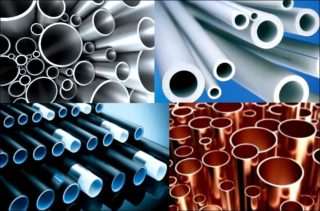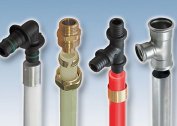Water supply systems use various fittings made of plastic and metal. The design and features of their application depend on the goals. It is necessary to consider the main types of connecting elements and deal with the characteristics of highways from popular materials in order to mount a high-quality pipeline.
The use of plastic pipes and fittings in the water supply
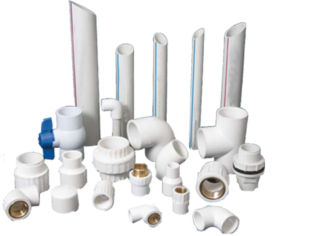 Polyethylene pipes are the most common when creating water supply systems. Products have a smooth surface, so that impurities are not deposited on the walls. The only drawback of polyethylene pipes is the possibility of use only when creating a cold water supply system. If a hot water line is laid, cross-linked polyethylene products are used, which are characterized by increased strength and resistance to high temperatures.
Polyethylene pipes are the most common when creating water supply systems. Products have a smooth surface, so that impurities are not deposited on the walls. The only drawback of polyethylene pipes is the possibility of use only when creating a cold water supply system. If a hot water line is laid, cross-linked polyethylene products are used, which are characterized by increased strength and resistance to high temperatures.
Install the water supply system using the connecting elements - fittings. When using polyethylene products, it turns out to create engineering systems without the use of complex equipment. With this solution, installation labor is reduced and waste is reduced.
Types of connecting elements
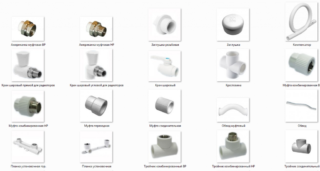 Fittings are classified according to purpose. The following models have been developed for metal products:
Fittings are classified according to purpose. The following models have been developed for metal products:
- fittings - necessary for connecting pipes with flexible bends;
- caps and caps - used when closing the final holes;
- adapters are installed when docking sections of different diameters;
- crosses - necessary for diluting the flow in several directions;
- tees, or collectors - are used to create branches from the main line;
- couplings - allow to extend pipes in a straight line;
- bends and angles - used to change the direction of the highway.
Depending on the material of manufacture, the fittings are divided into bronze, copper, steel, cast iron and brass. For flexible hoses, polypropylene and polyvinyl chloride products are used.
According to the method of joining, fittings are:
- compression;
- flanged;
- threaded;
- welding;
- crimp.
When installing plumbing equipment, all types of pipe fittings are equally used. When choosing components, it is necessary to focus on the estimated pressure in the water supply system and the diameter of the joined sections.
Production material
Pipes for water supply, depending on the material of manufacture:
- Steel. Connect with threaded fittings. Installation of such products requires the use of special tools - adjustable wrenches and gas wrenches, mechanisms for threading, a hacksaw. In addition, welding equipment and sealant tape are required. The advantages of steel lines are their strength and durability. Among the disadvantages are the complexity of installation and susceptibility to corrosion.
- Copper. They have a long service life (from 40 years) and high resistance to temperature extremes. The disadvantages include the need to use a soldering apparatus. If any area is damaged, it must be cut out and re-assembled.
- Metal-plastic. They have 3 layers: outer and inner of plastic, the main of metal. The advantages of metal plastic include high flexibility, no corrosion, quick installation and ease of repair.
- Polypropylene They can be reinforced (for hot water supply).Network sections are connected using tees, adapters and threaded couplings. The service life of polypropylene is 50 years. The disadvantages of the material include low flexibility. If a marriage is found on the site, it is cut out, and the pipeline is re-assembled.
- Crosslinked polypropylene. They are resistant to high pressure and temperature extremes, sufficient sound insulation and low thermal conductivity. Separate sections are connected by pressing the press sleeve. Fittings are reused. The only drawback of products from cross-linked polypropylene is a higher cost than the usual variety of modern material. The best prices for them can be found in the catalogs of Rehau.
- PVC pipes and fittings for water supply are the most budgetary and reliable. Resistant to water shocks, immune to the formation and development of bacteria, not exposed to ultraviolet radiation.
PVC pipes and fittings are more often used for hot water networks.
Specifications
 When creating water supply systems, polypropylene pipes are often used. The requirements for them are described in GOST 32415-2013. Main characteristics:
When creating water supply systems, polypropylene pipes are often used. The requirements for them are described in GOST 32415-2013. Main characteristics:
- Density - 0.91 kg / cm3. Despite the fact that the indicator is minimal against the background of similar materials, the products are characterized by high strength and hardness. In addition, polypropylene is immune to abrasion, due to which it tolerates the effects of abrasive particles.
- Low coefficient of thermal conductivity. Condensation does not accumulate on the surface.
- High strength. However, sharp bends and strong pressure lead to cracks. It is necessary to change the shape of products slowly.
- Resistance to destruction in aggressive environments. The risk of material damage arises from interaction with strong acids, or from prolonged heating.
The sizes of propylene pipes and fittings for water supply depend on the material of manufacture (PPR, PPH, PPB, PPS) and can have indicators from 16 to 1200 mm.
Key selection criteria
Laying water supply systems involves the selection of fittings and pipes of suitable diameter. When buying products, you should ask the seller about the availability of permits from the manufacturer. Plastic pipes and fittings for water supply have a lower cost and light weight, so they are more often used in housing construction.
It is worth paying attention to the assembly of the units - the distance between the flanges should be such that it is possible to easily tighten the bolts and install the valves while maintaining the tightness of the system. If this condition is met, the water supply will be resistant to a pressure of 12 atmospheres, which eliminates the risk of leaks.
Since polyethylene pipes are fusible, a low temperature soldering iron is used in the welding process. To connect such sections of the network, welded and compression fittings are used. When installing large diameter pipes, special heating devices are used.
Installation Steps
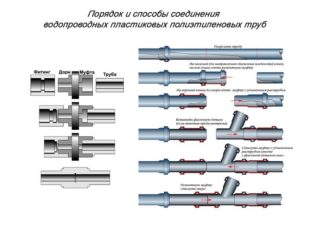 To install polypropylene pipes it is better to rent a special soldering iron. You will also need a pipe cutter (or a hacksaw for metal), a marker, a protractor or an angled ruler. For a complete set of tools, you must prepare an adjustable wrench.
To install polypropylene pipes it is better to rent a special soldering iron. You will also need a pipe cutter (or a hacksaw for metal), a marker, a protractor or an angled ruler. For a complete set of tools, you must prepare an adjustable wrench.
There are no special technological subtleties during the installation of polypropylene pipes, however, with a complete lack of work skills, difficulties may arise with the operation of the pipeline in the future. Sequencing:
- Cut pipe section.
- Strip the cut from burrs.
- Pick up and fit the right fitting.
- Put the appropriate nozzle on the polypropylene soldering iron.
- Turn on the device and wait for it to heat up.
- At the same time, insert the end of the pipe and the connecting element into the nozzle of the soldering iron, and then wait a few seconds (the time depends on the wall thickness).
- Remove the fitting and the water supply section from the nozzle and manually connect by inserting one element into another until it stops.
The peculiarity of installing a polypropylene water supply system is the need to quickly perform all actions.
